
Computational Condensed Matter
Scope & Guideline
Empowering Researchers with High-Quality, Peer-Reviewed Insights
Introduction
Aims and Scopes
- Computational Materials Science:
The journal publishes studies that utilize computational methods to explore and predict the properties of various materials, including metals, semiconductors, and complex oxides. - First-Principles Calculations:
A strong emphasis is placed on first-principles calculations, particularly using density functional theory (DFT), to derive insights into the electronic structure, mechanical properties, and thermal behavior of materials. - Optoelectronic Properties:
Research on the optoelectronic properties of materials, including their applications in solar cells, photodetectors, and light-emitting devices, is a key focus area. - Thermoelectric Materials:
The journal includes studies related to thermoelectric materials, highlighting their potential for energy conversion applications and the computational methods used to optimize their performance. - Magnetic Properties and Spintronics:
Investigations into the magnetic properties of materials, particularly those relevant to spintronics, are frequently presented, showcasing the role of computational methods in understanding magnetism at the atomic level. - Defect and Alloy Studies:
The effects of defects, doping, and alloying on the physical properties of materials are significant themes, often explored through computational modeling. - High-Pressure and Temperature Effects:
Research exploring the behavior of materials under extreme conditions, such as high pressure and temperature, is also prevalent, providing insights into phase transitions and stability.
Trending and Emerging
- 2D Materials and Heterostructures:
There is a growing interest in the study of two-dimensional materials and their heterostructures, particularly for their unique electronic and optical properties relevant to next-generation devices. - Machine Learning Integration:
The integration of machine learning techniques with computational modeling is on the rise, facilitating the discovery and design of new materials by predicting properties and behaviors. - Perovskite Materials:
Research on perovskite materials, especially their optoelectronic and thermoelectric properties, is increasingly popular, driven by their potential applications in renewable energy technologies. - Spintronics and Magnetic Materials:
The exploration of spintronic materials and their magnetic properties is becoming more prevalent, reflecting a broader interest in utilizing spin for information processing. - High-Throughput Computational Screening:
High-throughput computational methods for screening materials are emerging as a prominent theme, enabling rapid identification of promising candidates for various applications. - Environmental and Sustainable Materials:
There is a marked increase in research focused on environmentally friendly materials and sustainable technologies, including those for energy storage and conversion. - Quantum Computing Materials:
Emerging studies are investigating materials suitable for quantum computing applications, highlighting the intersection of condensed matter physics and quantum information science.
Declining or Waning
- Classical Molecular Dynamics Simulations:
There has been a noticeable decrease in publications focused solely on classical molecular dynamics simulations, as the field increasingly emphasizes quantum mechanical approaches such as DFT. - Experimental Correlation Studies:
Papers linking computational results with experimental data have become less frequent, possibly due to a growing focus on purely computational studies. - Traditional Semiconductor Studies:
Research on traditional semiconductor materials is waning, as newer materials such as perovskites and 2D materials gain more attention. - Single-Material Studies:
The journal has shifted away from studies focusing on single materials in isolation, favoring research that emphasizes complex systems, heterostructures, and composite materials. - Basic Theoretical Frameworks:
There is a decline in the publication of papers that primarily focus on foundational theoretical frameworks without substantial application to novel materials or systems.
Similar Journals
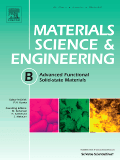
Materials Science and Engineering B-Advanced Functional Solid-State Materials
Advancing the Future of Solid-State MaterialsMaterials Science and Engineering B: Advanced Functional Solid-State Materials, published by Elsevier, stands as a pivotal platform in the realm of materials science, focusing on the development and characterization of advanced solid-state materials. With an ISSN of 0921-5107 and E-ISSN of 1873-4944, this journal operates out of the United Kingdom and addresses critical issues in condensed matter physics, mechanical engineering, and mechanics of materials. Its consistent recognition, evident in its Q2 quartile rankings across multiple engineering and physics categories and a respectable scope of convergence from 1988 to 2024, signifies its substantial contribution to the field. Researchers and professionals seeking a venue for cutting-edge work will appreciate the journal's commitment to advancing knowledge in functional materials, with its open access features ensuring that innovative findings are readily accessible. Join a community of leading scholars engaging with the latest advancements, shaping the future of materials science.
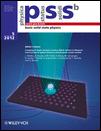
PHYSICA STATUS SOLIDI B-BASIC SOLID STATE PHYSICS
Advancing Knowledge in Condensed Matter SciencePHYSICA STATUS SOLIDI B-BASIC SOLID STATE PHYSICS, published by Wiley-VCH Verlag GmbH in Germany, is an esteemed journal within the condensed matter physics sphere, covering pivotal advancements in basic solid state physics. With a rich history dating back to 1961, it serves as a scholarly platform for researchers, professionals, and students alike, providing insights into the fundamental properties and applications of electronic, optical, and magnetic materials. The journal currently holds a respectable Q3 ranking in both Condensed Matter Physics and Electronic, Optical, and Magnetic Materials as of 2023, indicating its impactful contributions to these fields despite its competitive landscape. While it does not offer open access, its comprehensive research findings are critical for those engaged in innovative material science research. With a convergence period extending to 2024, PHYSICA STATUS SOLIDI B continues to play a significant role in facilitating knowledge exchange and fostering advancements in solid state physics.

Journal of Superconductivity and Novel Magnetism
Connecting Researchers to the Latest in SuperconductivityJournal of Superconductivity and Novel Magnetism, published by SPRINGER, is a premier venue for research in the dynamic fields of condensed matter physics and materials science. With an ISSN of 1557-1939 and an E-ISSN of 1557-1947, this journal provides an essential platform for disseminating innovative studies examining the complexities of superconductivity and magnetic phenomena. The journal is recognized for its contributions, holding a Q3 quartile ranking in both condensed matter physics and electronic, optical, and magnetic materials as of 2023. With a commitment to rigor and relevance, it features research that breaks new ground in understanding the properties and applications of superconducting materials, aiming to bridge fundamental science with technological advancements. Despite its lack of open access, the journal remains pivotal for researchers, professionals, and students keen to stay abreast of cutting-edge developments in the field, making it an indispensable resource for cultivating knowledge and promoting collaboration.
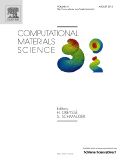
COMPUTATIONAL MATERIALS SCIENCE
Unlocking the Secrets of Materials with Computational TechniquesCOMPUTATIONAL MATERIALS SCIENCE is a prestigious academic journal dedicated to the dissemination of innovative research in the field of computational materials science, emphasizing the interplay between computational methodologies and materials engineering. Published by ELSEVIER in the Netherlands, this journal showcases high-impact articles that contribute significantly to the understanding of material properties through computational techniques. As evidenced by its 2023 Scopus Rankings, which place it in the top quartiles across multiple disciplines including Computer Science, Materials Science, and Physics and Astronomy, it is a vital resource for researchers, professionals, and students alike. With a focus on advancing scientific knowledge and practical applications, COMPUTATIONAL MATERIALS SCIENCE aims to bridge the gap between theoretical investigations and experimental validation. Explore a wealth of cutting-edge research designed to inspire the next generation of innovations in materials science through this esteemed publication.
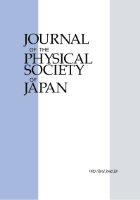
JOURNAL OF THE PHYSICAL SOCIETY OF JAPAN
Connecting Theory with Application in PhysicsThe JOURNAL OF THE PHYSICAL SOCIETY OF JAPAN, published by the Physical Society of Japan, has been at the forefront of advancing knowledge in the field of Physics and Astronomy since its inception in 1946. With a commendable reputation reflected in its Q2 ranking within its category for 2023, this journal serves as a vital platform for disseminating high-quality research and innovative concepts. Researchers and professionals alike can engage with cutting-edge studies and reviews that span a diverse range of topics pivotal to the physical sciences. Although the journal does not currently operate with an open access model, it maintains a robust impact on the global physics community, evidenced by its placement in the 59th percentile among a competitive pool of 243 journals. With an unwavering commitment to bridging theory and application, the JOURNAL OF THE PHYSICAL SOCIETY OF JAPAN continues to inspire and cultivate scholarly discourse and collaboration across disciplines.
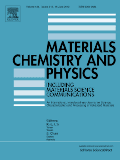
MATERIALS CHEMISTRY AND PHYSICS
Advancing Knowledge in Materials Chemistry and PhysicsMATERIALS CHEMISTRY AND PHYSICS is a leading peer-reviewed journal published by Elsevier Science SA, focusing on the intersection of materials science and condensed matter physics. With an esteemed impact factor and a distinguished reputation in its field, this journal holds a Q1 ranking in Condensed Matter Physics and a Q2 ranking in miscellaneous Materials Science categories as of 2023. Spanning over three decades since its inception in 1983, it provides a vital platform for researchers, professionals, and students to disseminate cutting-edge findings and innovations in materials characterization, properties, and applications. The journal is indexed in Scopus, boasting impressive rankings that reflect its commitment to publishing high-quality research. Although it does not currently offer an Open Access option, it remains an essential resource for those seeking to stay at the forefront of materials chemistry and physics.
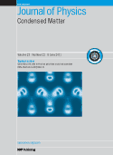
JOURNAL OF PHYSICS-CONDENSED MATTER
Illuminating the Evolving Landscape of Materials Research.JOURNAL OF PHYSICS-CONDENSED MATTER, published by IOP Publishing Ltd, stands as a premier platform for the dissemination of impactful research in the fields of condensed matter physics and materials science. Since its inception in 1989, this journal has successfully bridged the gap between fundamental and applied research, delivering cutting-edge findings pertinent to both the academic community and industry professionals. Ranking in the Q2 category for both Condensed Matter Physics and Materials Science, it holds a respectable position within the scientific community, as evidenced by its Scopus rankings. With a commitment to fostering innovative research and promoting open dialogue, the journal offers a substantial collection of articles that contribute to the evolving landscape of materials science and physics. Researchers and students are encouraged to engage with the journal’s rich content, which not only enhances their academic pursuits but also plays a crucial role in advancing technologies based on solid-state materials.

PHYSICAL REVIEW B
Advancing Understanding in Condensed Matter PhysicsPHYSICAL REVIEW B, published by the American Physical Society, is a leading journal in the field of condensed matter physics and materials science, particularly focusing on electronic, optical, and magnetic materials. With an ISSN of 2469-9950 and an E-ISSN of 2469-9969, this periodical has garnered a prestigious reputation, achieving a Q1 ranking in both relevant categories as of 2023. The journal has recorded significant impact as reflected in its Scopus ranks, notably positioned at #95 out of 434 in Condensed Matter Physics and #75 out of 284 in the Materials Science sector, illustrating its importance in advancing research and discussions in these critical areas. Although it does not offer open access, PHYSICAL REVIEW B remains an invaluable resource for academics, researchers, and professionals seeking to increase their understanding of contemporary issues in condensed matter and material sciences. Established in 2005, this journal continues to foster innovation and dissemination of knowledge, making it a cornerstone publication for those engaged in cutting-edge research.

JOURNAL OF PHYSICS AND CHEMISTRY OF SOLIDS
Exploring the Interplay of Physics and ChemistryJOURNAL OF PHYSICS AND CHEMISTRY OF SOLIDS, published by Pergamon-Elsevier Science Ltd, is a distinguished international journal that has been at the forefront of disseminating cutting-edge research in the fields of physics, chemistry, and materials science since its inception in 1956. This journal, which is recognized for its high impact in the Q2 category across multiple subjects—including Chemistry (miscellaneous), Condensed Matter Physics, and Materials Science—serves as a vital platform for researchers, professionals, and students to engage with significant advances in solid-state physics and chemistry. With Scopus rankings placing it in the top 15% of its field across various domains, the journal plays a crucial role in shaping the scientific dialogue surrounding materials properties, synthesis, and applications. Although it does not currently offer open access options, the presented research is widely recognized for its quality and relevance, ensuring that published works contribute meaningfully to ongoing scholarly discussions.

Advances in Condensed Matter Physics
Accelerating Insights in Nanotechnology and MoreAdvances in Condensed Matter Physics is a distinguished journal published by HINDAWI LTD, dedicated to the rapid dissemination of high-quality research in the field of condensed matter physics. Since its inception in 2008, this Open Access journal has facilitated wide accessibility to cutting-edge findings and theoretical advancements, with aims to foster collaboration and innovation within the scientific community. With an ISSN of 1687-8108 and an E-ISSN of 1687-8124, the journal covers an extensive range of topics, from quantum materials to nanotechnology, ensuring relevance and engagement across various sub-disciplines. As a testament to its impact in the field, it is ranked in the Q3 category for 2023 within Scopus and holds a position in the 34th percentile for physics and astronomy. The journal's continuous commitment to publishing significant exploratory research until 2024 makes it a pivotal resource for researchers, professionals, and students eager to stay on the leading edge of condensed matter physics advancements.